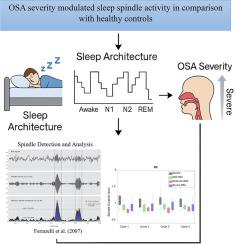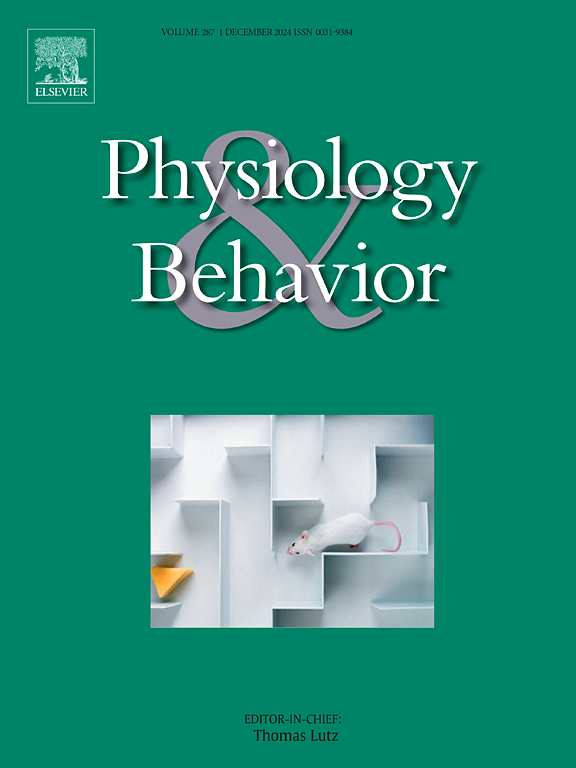Impact of obstructive sleep apnea on sleep cycles and spindle dynamics: A polysomnographic study
IF 2.5
3区 医学
Q2 BEHAVIORAL SCIENCES
引用次数: 0
Abstract
Sleep spindles and the temporal organization of sleep are essential for restorative and cognitive functions, yet their disruption in obstructive sleep apnea (OSA) remains poorly understood. This study examined spindle density and duration across sleep cycles in 30 OSA patients and 22 controls using full-night polysomnography. While total sleep time and stage proportions were similar between groups, sleep efficiency and arousal index worsened with OSA severity. Spindle duration in N2 was significantly reduced in moderate OSA, particularly at frontal sites, with a Group × Cycle interaction indicating altered temporal dynamics, with a significant difference primarily observed in the first sleep cycle. In N3 sleep, spindle density was significantly reduced in severe OSA compared to controls during the fourth sleep cycle. However, no significant group × cycle interaction was observed, indicating limited evidence for progressive spindle density decline with increasing OSA severity. These findings suggest that OSA severity impacts specific temporal aspects of spindle dynamics during the night, yet the alterations are stage-, cycle-, and severity-dependent rather than progressive across severity levels, emphasizing the potential cognitive and clinical relevance of disrupted spindle activity in OSA. Further research is warranted to clarify the mechanisms by which OSA affects sleep spindle modulation.

阻塞性睡眠呼吸暂停对睡眠周期和纺锤体动态的影响:一项多导睡眠图研究。
睡眠纺锤波和睡眠的时间组织对恢复和认知功能至关重要,但它们在阻塞性睡眠呼吸暂停(OSA)中的破坏作用仍然知之甚少。本研究使用全夜间多导睡眠图检测了30名OSA患者和22名对照者的纺锤体密度和睡眠周期的持续时间。虽然两组之间的总睡眠时间和阶段比例相似,但睡眠效率和唤醒指数随着OSA严重程度而恶化。中度OSA患者N2期纺锤体持续时间显著减少,尤其是额叶部位,组 × 周期相互作用表明时间动态改变,主要在第一个睡眠周期观察到显著差异。在N3睡眠中,与对照组相比,在第四个睡眠周期中,严重OSA患者的纺锤体密度显著降低。然而,没有观察到显著的组 × 周期相互作用,表明随着OSA严重程度的增加,纺锤体密度逐渐下降的证据有限。这些研究结果表明,OSA严重程度会影响夜间纺锤体动态的特定时间方面,但这种改变是阶段、周期和严重程度相关的,而不是在严重程度上渐进式的,这强调了OSA中纺锤体活动中断的潜在认知和临床相关性。需要进一步的研究来阐明OSA影响睡眠纺锤体调节的机制。
本文章由计算机程序翻译,如有差异,请以英文原文为准。
求助全文
约1分钟内获得全文
求助全文
来源期刊

Physiology & Behavior
医学-行为科学
CiteScore
5.70
自引率
3.40%
发文量
274
审稿时长
47 days
期刊介绍:
Physiology & Behavior is aimed at the causal physiological mechanisms of behavior and its modulation by environmental factors. The journal invites original reports in the broad area of behavioral and cognitive neuroscience, in which at least one variable is physiological and the primary emphasis and theoretical context are behavioral. The range of subjects includes behavioral neuroendocrinology, psychoneuroimmunology, learning and memory, ingestion, social behavior, and studies related to the mechanisms of psychopathology. Contemporary reviews and theoretical articles are welcomed and the Editors invite such proposals from interested authors.
 求助内容:
求助内容: 应助结果提醒方式:
应助结果提醒方式:


